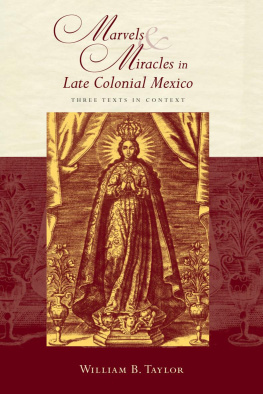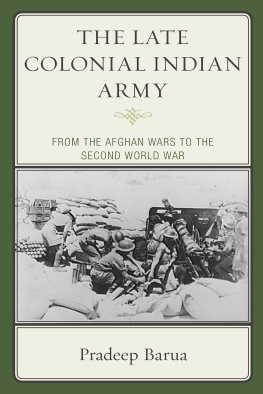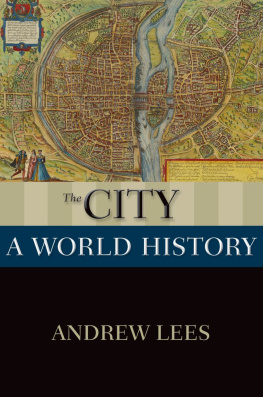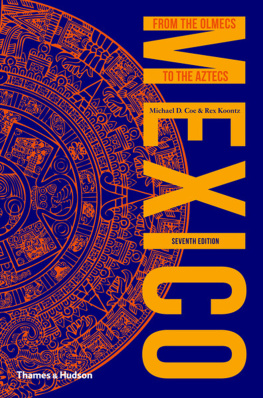Scardaville - Crime and the urban poor: Mexico City in the late colonial period
Here you can read online Scardaville - Crime and the urban poor: Mexico City in the late colonial period full text of the book (entire story) in english for free. Download pdf and epub, get meaning, cover and reviews about this ebook. year: 1977, genre: Non-fiction. Description of the work, (preface) as well as reviews are available. Best literature library LitArk.com created for fans of good reading and offers a wide selection of genres:
Romance novel
Science fiction
Adventure
Detective
Science
History
Home and family
Prose
Art
Politics
Computer
Non-fiction
Religion
Business
Children
Humor
Choose a favorite category and find really read worthwhile books. Enjoy immersion in the world of imagination, feel the emotions of the characters or learn something new for yourself, make an fascinating discovery.

- Book:Crime and the urban poor: Mexico City in the late colonial period
- Author:
- Genre:
- Year:1977
- Rating:4 / 5
- Favourites:Add to favourites
- Your mark:
- 80
- 1
- 2
- 3
- 4
- 5
Crime and the urban poor: Mexico City in the late colonial period: summary, description and annotation
We offer to read an annotation, description, summary or preface (depends on what the author of the book "Crime and the urban poor: Mexico City in the late colonial period" wrote himself). If you haven't found the necessary information about the book — write in the comments, we will try to find it.
Scardaville: author's other books
Who wrote Crime and the urban poor: Mexico City in the late colonial period? Find out the surname, the name of the author of the book and a list of all author's works by series.
Crime and the urban poor: Mexico City in the late colonial period — read online for free the complete book (whole text) full work
Below is the text of the book, divided by pages. System saving the place of the last page read, allows you to conveniently read the book "Crime and the urban poor: Mexico City in the late colonial period" online for free, without having to search again every time where you left off. Put a bookmark, and you can go to the page where you finished reading at any time.
Font size:
Interval:
Bookmark:
GRIME AND THE URBAN POOR: MEXICO CITY IN THE LATE COLONIAL PERIOD
BY
MIGIiAEL CHARLES SGARDAVILLE
A DISSERTATION PRESENTED TO THE GRADUATE COUNCIL
OF THE UNIVERSITY OF FLORIDA
IN PARTIAL FULFILLMENT OF THE REQUIREMENTS FOR THE
DEGREE OF DOCTOR OF PHILOSOPHY
UNIVERSITY OF FLORIDA 1977
COPYRIGHT BY
MICHAEL CHARLES SCARDAVILLE
Dedicated to the memory of my father
PREFACE
The purpose of the dissertation is to examine lower class life in Mexico City in the late colonial period. Although this period ranges from the onset of the administration of Viceroy Croix in I766 to the end of the tavern reform movement in 1811, the bulk of the study concentrates on the three decades folloKing the reform of the municipal criminal judicial system in I783.
The comparative inaccessibility and lack of data on urban non-elites make study of such groups difficult. The poor did not leave behind accounts of their lives, and the documentation that has survived has generally been written by viceregal and municipal bureaucrats hostile to the lifestyle of the lower classes. In addition to notary records, the poor left a legacy of their behavior and daily lives in the city police and court records located today in the Archive Judicial del Tribunal and Archive General del Juzgado. From aggregate arrest statistics collected from police Inventories (Libros de Reos) and from testimonies taken from informal and formal criminal cases, I will analyze several types of prevalent crimes, such as common-law marriage, desertion, and property and drink offenses, which were structured into lower class society. I will conclude by discussing how the colonial authorities treated the criminal offenders in the lower courts of Mexico City.
This study is written on the assumption that criminal statistics, although incomplete in their coverage of all crime, reflect values, attitudes, and daily problems among the poor. I will examine crime not as a series of independent criminal acts, but as a dimension of lower class behavior. Preoccupation with criminal statistics is not an end in itself, but represents only one approach to study the urban poor. Statistical calculations, used judiciously, can offer more insight into lower class society in late colonial Mexico City.
Other materials supplement the criminal records. The Archive General de la Nacion contains abundant documentation on tavern reforms, population, viceregal policies toward crime, creation of police forces, and problems of law enforcement. The Archive del Antiguo Ayuntamiento offers related information, particularly on legal taverns and street lighting. The Libros de Reos consist of over 7,000 listings of persons of both sexes arrested between 1795 and 1807, and with such a large sample of the lower class population, I occasionally use the arrest recorxis as census-type data. I^tterns of migration from the provinces, age at marriage figures, and occupational distributions by age, race, and marital status were all constructed from the police and coiurt inventories.
Whenever possible, I rounded off percentages in the statistical calculations, but whenever slight differences were necessary for analysis, such as in the types of court sentences or the incidence of arrests in 1798, I listed the figures to one decimal point. Unless noted, all statistical data not footnoted and all tables listed at the end of each chapter are based on analysis of the nine extant Libros de Reos. Tables presenting data from 1798 were constructed solely from the three police and court inventories pertaining to that year.
Many people have contributed to the present study. My chalnnan, Dr. Lyle N. McAlister, has not only sparked my interest in colonial Mexican history, but has also provided the necessary guidance and has given the necessary freedom to undertake such a project. I am also indebted to Dr. Claude G. Sturgill for his careful reading of the manuscript and tables, his supervision of the quantitative methodology, and for other favors too numerous to mention. Through the assistance of Mrs. Lilian McDowell, the Department of History has been more than generous with computer funds, and Jean Holtzer of CIRCA and Rod Mundy and Jim Lewis of the Political Science Statistical Lab have provided necessary instruction in the Statistical lockage for the Social Sciences and have helped untangle many difficulties with the computer runs. The staffs at the AJT and AGJ also patiently answered the many questions I had during my eight months of work on the Libros de Reos and criminal cases.
Without my wife, Barbara, however, this dissertation would never have been completed. She gave me support and encouragement throughout these long years of graduate school, particularly after long days in the archives and on the buses of Mexico City. Her typing and editing have also made my work that much easier. And finally, our daughter, Melissa, has also contributed to the dissertation by giving us much joy in life after long bouts at the writing and typing Ubles.
GOOTEOTS
PflEFAGE iv
ABSTRACT vlii
CHAPTER
ONE GRIME AND THE URBAN POOR: AN OVERVIEW 1
Notes ,, 26
Tables 34
TWO MIGRATION AITO TOVERTY 48
Notes , , -^3
Tables "pg
THREE PROPERTY GRIMES 9O
Notes 123
Tables I3O
FOUR FAMILY LIFE 140
Notes 183
Tables I9I
FIVE DRINK AND DRIVING PLAGES 208
Notes 252
Tables . 265
SIX THE COURTS, JUSTICE, AND THE URBAN POOR 272
Notes 326
Tables 327
CONCLUSION 331
APPENDIX 3^
BIBLIOGRAPHY 335
BIOGRAiraCAL SKETCH 366
ABSTRACT OF DISSERTATION PRESENTED TO THE GRADUATE COUNCIL
OF THE UNIVERSITY OF FLORIDA IN PARTIAL FULFILLMENT
OF THE REQUIREMENTS FOR THE DEGREE
OF DOCTOR OF PHILOSOPHY
CRIME AND THE URBAN POOR: MEXICO CITY IN THE UTE COLONIAL PERIOD
BY
MICHAEL CHARLES SCARDAVILLE AUGUST 1977
Chairman: Lyle N. McAlister, Ph.D. Major Department: History
The dissertation examines lower class life in Mexico City in the late colonial period (1766-I8II) through computer-assisted analysis of 7,067 arrests and summary judicial hearings. Census data and viceregal and municipal decrees supplement the criminal records. The urban poor adopted patterns of conduct which the laws and social elite deemed criminal. Within the lower class subculture, however, certain criminal acts such as drunkenness, common-law marriage, and petty theft represented accepted patterns of behavior, and consequently, such acts yield insight into several dimensions of lower class life.
The poor, comprising 85 per cent of Mexico City's population, did not benefit from the upswing in the economy in the late colonial period. Caused by a constant influx of migrants from the provinces, a labor surplus kept wages below subsistence levels. Although wages increased by as much as 25 per cent, the price of com more than doubled.
The problem of survival led many of the poor to adopt criminal forms of behavior. Contrary to contemporary opinion, the criminals, popularly called Igperos , were neither marginal types nor dregs of the lower classes. They were drawn from all racial and occupational groups, with a large percentage representing the socially superior Spaniards and the economically superior artisans. The llperos were a cross section of, not a distinct class within the urban poor.
Alcoholic beverages assumed a central role in the lives of the poor. Drink-related crimes accounted for almost one-half of the arrests in Mexico City. Over 1,600 legal and illegal taverns populated the city. Known to the police as breeding grounds for criminal activities, the drinking places represented to the poor reassuring institutions in an economically deprived environment. Reform of the pulquerlas in 1792-93 and the vinaterlas in 1810-11 failed because of hostility from the poor as well as from influential hacendados who profited from the immoderate consumption of intoxicants.
Next pageFont size:
Interval:
Bookmark:
Similar books «Crime and the urban poor: Mexico City in the late colonial period»
Look at similar books to Crime and the urban poor: Mexico City in the late colonial period. We have selected literature similar in name and meaning in the hope of providing readers with more options to find new, interesting, not yet read works.
Discussion, reviews of the book Crime and the urban poor: Mexico City in the late colonial period and just readers' own opinions. Leave your comments, write what you think about the work, its meaning or the main characters. Specify what exactly you liked and what you didn't like, and why you think so.





